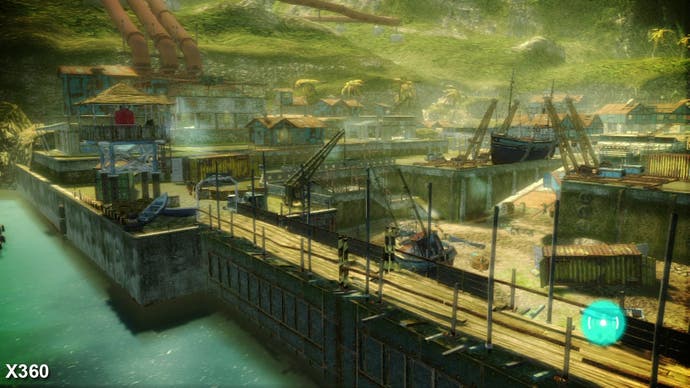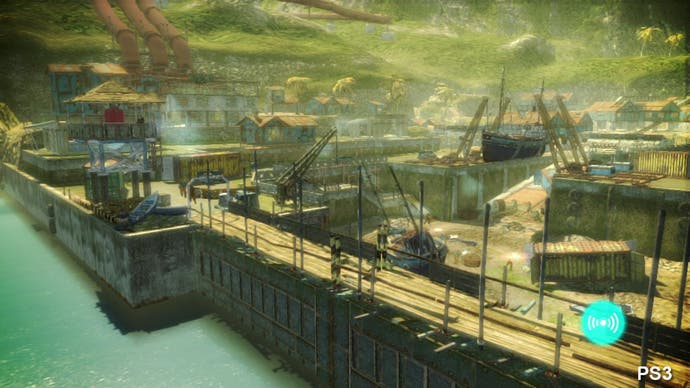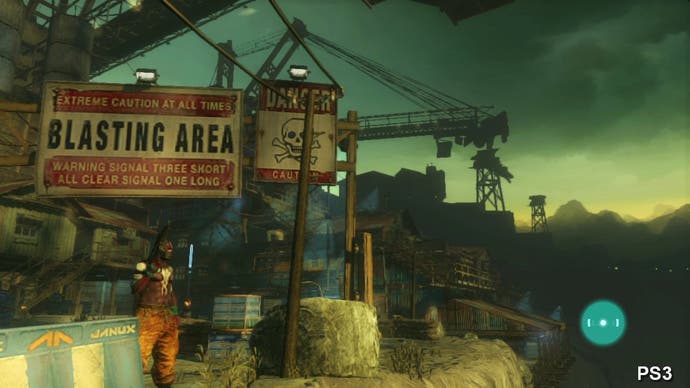Face-Off: Bodycount
Fade to Black.
| - | Xbox 360 | PlayStation 3 |
|---|---|---|
| Disc Size | 5.6GB | 5.59GB |
| Install | 5.6GB (optional) | - |
| Surround Support | Dolby Digital | Dolby Digital, DTS, 5.1LPCM, 7.1LPCM |
Conceived as the spiritual successor to Criterion's much-loved Black, Bodycount fails to make an impact on the battlefield, delivering an experience that feels rushed, unpolished and to a certain extent unfinished. It's a bitter blow for those hoping to get a current-generation taste of what made the Burnout makers' FPS so much fun to play. In that respect, the baton has been passed to EA stablemates DICE, and we can only hope that Battlefield 3 is the game that delivers.
The main talking point in Bodycount is the inclusion of destructible environments. Unfortunately, the harsh reality is that it does very little for the gameplay experience. Sure enough, windows and doors can be blasted to pieces, ceilings collapse, and walls are routinely demolished, but the range of destruction on offer is limited to specific objects, leaving this element of the game feeling somewhat basic in nature. It's a shame, because some of the environments on offer - a meagre five if you care to count - do come across as being fairly well designed, if a little small.
But what about the multi-platform conversion aspect? Has Codemasters' new Guildford studio successfully provided a graphically solid experience on both formats? How well does the core technology hold up to handling a fast-paced shooter, where the rendering load can be particularly unpredictable?
Unfortunately, as our head-to-head video and Bodycount 720p comparison gallery reveal, the results are particularly disappointing. There are a number of issues that impact on the visual consistency of the game, ranging from poor image quality, low-resolution effects, and unstable performance, all of which serve only to distract you from the gameplay on offer. In truth, many of these problems are more than likely down to the unoptimised and unpolished nature of the final product, rather than the underlying technology behind it.
In terms of native resolution, both games appear to be sub-HD. Bodycount appears to renders at 1024x720 on the Xbox 360 and 1024x640 on the PS3, both featuring post-process anti-aliasing. Image quality is noticeably better on the Microsoft platform, with smoother edges and less in the way of blur. There's visibly more detail on offer in some scenes too, although the differences we see are larger than what we'd expect to find from a mere 80-line deficit - there's another important factor at play here, and perhaps that comes in the form of the anti-aliasing on offer.
It's difficult to speak with absolute authority on the latest forms of advanced post-process anti-aliasing (their impact on image quality seems to change on a game by game basis) but it seems to be the case that FXAA is used on the 360, which appears to deliver ample coverage over and above what 2x MSAA (multi-sampling anti-aliasing) would usually provide. Sub-pixel details also benefit from some smoothing too, at the expense of some slight, additional blurring. Along with the upscaling taking place, things do look a little soft, and there are still some unsightly edge artifacts in full view, particularly evident in smaller environmental details.




Quite what is going on with the PS3 version isn't as clear. Another post-process anti-aliasing solution definitely appears to be present, but which one - custom or otherwise - we can't say for sure. From the nature of the pixel structure, our best bet is that some kind of simpler edge filter is being implemented, which seems to blur the overall image somewhat whilst providing poor coverage in comparison to the solution found on the 360. Alternatively, it may simply be the case that the same filter as the Xbox version is being used, and it just doesn't perform as well on the lower-resolution framebuffer.
While the basic rendering set-up obviously impacts on the overall quality of the artwork, we also find that a few assets have been either pared back or are missing on the PS3, although generally speaking both versions are still pretty close. For example, some of the textures dotted about the environments are a little lower in resolution, appearing less detailed as a result. Texture filtering takes a hit, with the sometimes harsh mip-map transitions hinting that a trilinear solution is present, rather than a low level of AF (anisotropic filtering). Also, we see that there are fewer plants and foliage elements scattered about the landscape, along with some that are smaller and less detailed. All of this suggests that Codemasters struggled to an extent with the split memory setup of the PlayStation 3.
Overall, this leads to parts of the environment on the Sony console looking a touch more barren in places, with clarity and sharpness also taking a hit. Some of these differences only really stick out in a direct A to B comparison, so generally don't jump straight out at you when playing normally. A minor plus point to bear in mind is that the PS3 game appears to have a very minor advantage when it comes to the engine steaming in higher quality assets.








